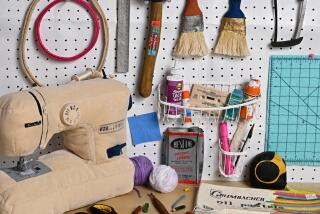Master Class Crafts Violin Makers
A month ago, Lee Siggers bought a violin repair shop in his home city of Fort Worth from a woman who was dying of cancer. Last week the retired Navy officer traveled 1,400 miles to Thousand Oaks to fulfill the womanâs dying wish.
As a condition of the sale, the shop owner made Siggers promise to attend the California Summer String Institute at California Lutheran University, the only violin-making class of its kind on the West Coast.
âShe said, âYou donât touch a bow or violin until you go to that school,â â said Siggers, who became interested in the art when he started taking his 12-year-old daughter to violin lessons.
Six months ago, he began taking lessons himself and learned of the womanâs shop.
He arrived in Thousand Oaks last week with four violins in need of new necks and fingerboards. They were among 50 violins in need of repair that had been acquired by the shop over the years.
âThis was the quickest way to get some of them ready,â he said. âIâm learning to do all of those delicate things to put them back together.â
The three-week violin- and bow-making class at Cal Lutheran runs through the end of the month.
Since the program began 12 years ago, students have traveled from throughout the country to this tiny studio space to learn the precision and intricacies of the craft from master violin maker Boyd Poulsen.
Poulsen, who has taught the small class for five years, studied music classically and was a bass player in Los Angeles in 1960 when he began studying the art of violin making as an apprentice in several downtown shops.
âMy first fascination was in what made these instrumentsâ sound,â said Poulsen, whose interest later expanded to repair and construction.
He continued to learn the art in Paris and Zurich, Switzerland, and ran repair shops in Reno, San Francisco and San Mateo, Calif., before settling at a shop in the Sierra, where he still lives.
Over the years he has made 55 instruments--some violas and cellos, but mostly violins--and more than 300 bows.
Much of violin making depends on the maker, Poulsen said. Some people can complete a handmade violin in a month; others will take four to five years until they smooth it to their liking.
âI donât think speed is of great importance,â he said. âIt is understanding the procedures that matters.â
Poulsen teaches traditional European techniques, largely relying on hand tools and 400-year-old methods.
On a recent day, nine students leaned over workbenches in the studio at Cal Lutheran. Some made intricate repairs to century-old instruments, others built and shaped instruments of their own.
For the beginners, Poulsen first taught them how to hone their tools. Then he had them use an aluminum pattern to trace the shape of the violin body onto what is called an inside form, made of plywood.
First-time student Michael Black spent the afternoon planing the sides of the inside form, flattening and smoothing.
After several hours, Black, a vice president of sales and marketing for a steel company in Portland, Ore., would tackle the wood for the instrument, carving the thickness down to a millimeter so that the maple strips can be bent with hot irons around the inside form to create the sides of the instrument.
Across the room, Berkeley acupuncturist Peter Van Arsdale used planes and chisels to arch the top of his first cello. Spruce shavings fell to the floor as he ran a plane across one side and smoothed each stroke with his palm.
âYou can start to hear it,â said Van Arsdale as he stood the front piece of the cello on end and tapped the arch that was slowly forming across the middle. âThatâs part of the mystery of it: trying to develop the sound as you go along.â
After years spent fixing bowstrings and the bridges of broken violins of kindergartners in College Place, Wash., music teacher Lorrie Kravig sought the class.
âSince I started teaching violin, things would break and there was no one there to fix them,â said Kravig, patiently planing the sides of the form.
âIt helps me understand how the instrument is put together, and the more I know, the more Iâll be able to repair them with integrity,â she said. âEach instrument has the makerâs signature in it. So I guess what Iâm trying to do is do no harm.â
That is the mantra for restorers, who strive to repair the antique violins without altering their sound or quality.
For the makers, the workshop is a chance to perfect an art form of their own.
In April, Van Arsdale completed the violin he was working on at last yearâs summer institute.
âI just love it; itâs a passion for me,â he said.
âItâs so rewarding to build an instrument and have someone play it and sound beautiful,â he added. âAnd thereâs something satisfying about building something that will be around for years longer than I will.â


